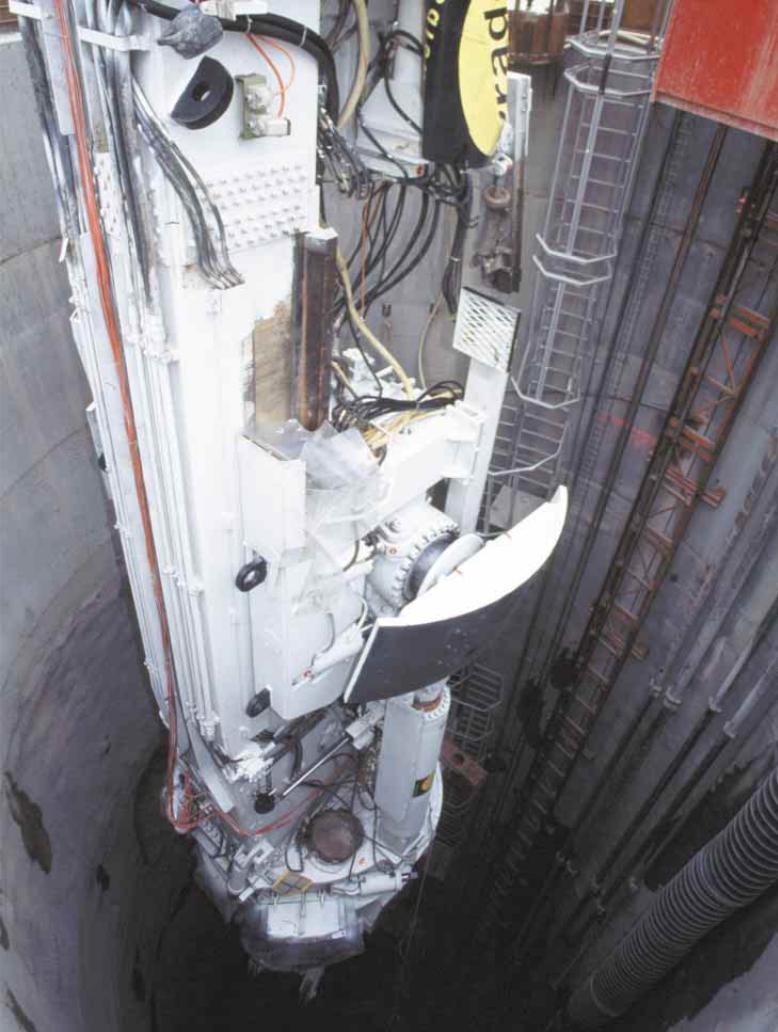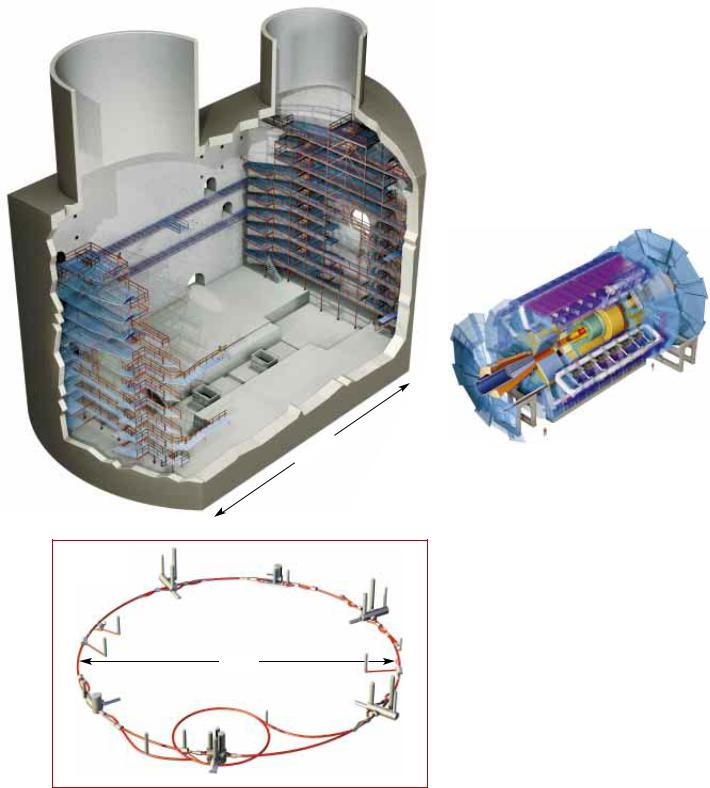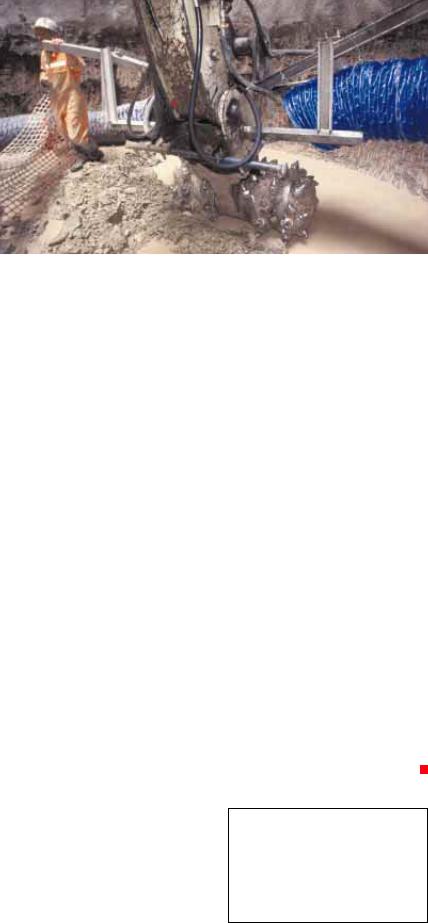
Тысячи-1 / !_Мои 1000_! / Подземная регистрация (БАК) / Subterranean speed record
.pdfSubterranean
Speed Record
The massive installment currently under construction near Geneva will be the fastest particle accelerator ever built. When it opens in 2005, it will also be the largest science experiment in the world
by Sasha Nemecek
O
52 |
THE POWERFUL, THE STRONG, THE FAST |
CERN PHOTO
Copyright 1999 Scientific American, Inc.

JOURNEY TO THE CENTER OF THE EARTH: A tunnel-boring machine is slowly lowered down a concrete-lined shaftway at CERN, the European laboratory for particle physics. The new, ultrafast particle accelerator now being built requires the excavation of two immense underground chambers as well as connecting tunnels more than 300 feet below the surface.
Copyright 1999 Scientific American, Inc.

FIERSTEINDAVID |
175 |
FEET |
|
||
|
|
LARGE
HADRON
COLLIDER
CMS
5 MILES
ALICE |
LHCb |
ATLAS
ence and some 330 feet underground. (Particle accelerators are built underground for a variety of reasons, including the increased stability afforded by the surrounding rock.) Because the beams collide with so much force, the impact produces an impressive spray of particles that scatter in all directions. Centered on the crash sites are detectors, each several
stories tall, that enable scientists to monitor the newborn particles.
Detectors for these large colliders must be huge themselves for two reasons. First, the collisions researchers are trying to observe produce particles that fly outward with tremendous energy, which would simply overwhelm a small detector. Second, particle physicists study the curved
COLOSSAL CAVITY: The 6,600-ton ATLAS detector (below), now being assembled for the Large Hadron Collider, will be housed in a chamber large enough to fit a six-story building (top left); the entire assembly will be more than 300 feet below ground level. The ATLAS detector is one of four being built for the LHC; work is also in progress on the CMS, ALICE and LHCb detectors (bottom left).
path of these dispersing particles to learn about the particles’ momenta, which relates to their mass, speed and direction. Longer paths allow more precise measurements of direction and curvature.
Although the LHC’s accelerator will be housed in the same 17 miles of tunnel that LEP occupies now (with just a few short connecting segments added), workers must construct immense underground chambers for two of the four new LHC detectors. One of the two larger devices is known as ATLAS, short for a toroidal LHC apparatus. When completed in 2002, the concrete chamber that will house ATLAS will be large enough to hold a six-story building. Specifically, it will be 115 feet tall (including the thick outer walls) with an essentially rectangular base 100 feet by 175 feet— all more than 100 yards below ground.
But at the time of my visit, construction on ATLAS was still relatively close to the surface. Jean-Luc Baldy, the head civil engineer on the LHC project, took me on a tour of the ATLAS site, where workers had hollowed out the first 75 feet or so of two concrete-lined vertical tubes that will eventually be used for shuttling
54 SCIENTIFIC AMERICAN PRESENTS |
THE POWERFUL, THE STRONG, THE FAST |
Copyright 1999 Scientific American, Inc.

people and equipment down to the chamber. The largest of these tubes is roughly 60 feet across, to accommodate the dimensions of some of the 6,600-ton detector’s largest parts. An old shaftway, left over from when LEP was installed, was also being revamped for use in ATLAS construction. At Baldy’s insistence (I’m no fan of heights), I peered down this tube, which plunges more than 300 feet below ground. Only after I recovered from vertigo did Baldy inform me that the men I saw were only halfway down.
Baldy, who also worked as a CERN engineer during the construction of LEP’s tunnel, explained the challenges presented by the ATLAS chamber. It will be the largest underground structure ever built in the type of rock found here—sand- stone and marl, both considerably softer and less stable than bedrock such as granite. So Baldy and his fellow engineers have recommended extending 65-foot-long steel rods from the exterior of the chamber into the surrounding rock to reinforce the walls. One of Baldy’s CERN colleagues, Hans Hoffmann, the technical coordinator for the ATLAS project, described the finished product as “look- [ing] like a porcupine.”
Aprimary goal of the LHC project is to produce and observe the elusive Higgs boson, a particle associated with the
Higgs field. Physicists theorize that space is filled with the Higgs field, and that subatomic particles such as quarks and leptons acquire mass by interacting with this field. Capturing the Higgs boson— or at least some evidence that the LHC produced it—is a sizable task. According to Hoffmann, when the beams of protons intersect within the ATLAS detector, one billion collisions a second should result. To capture this rapid-fire activity, ATLAS must have more than 150 million sensors.
Hoffmann, a particle physicist by training, is head of the team devising the equipment that will fill the expanse of the ATLAS chamber once Baldy’s crew is finished. Some 1,800 scientists from around the world have contributed to the ATLAS detector, making the organizational engineering at times “more diffi-
CERN PHOTO
UNEARTHING DELIGHTS: Heavy equipment must be used to excavate the numerous shaftways and underground chambers required for the LHC. Workers will move nearly one million tons of dirt in all.
cult than the machine problems,” Hoffmann said, chuckling. That might be true, but the ATLAS sensors themselves required an impressive feat of engineering.
Hoffmann referred to the instruments in the very center of ATLAS as “a mechanical engineer’s dream.” To measure the paths of electrically charged particles, the ATLAS designers plan to assemble some 400,000 plastic straws (obviously not the kind you drink with) standing lengthwise and arranged in a ring several feet across; each straw will have a wire running down its center and a high voltage between the wire and the straw wall. A particle that passes through the straw will induce electrical pulses that can be recorded; a detailed analysis of these data will allow scientists to assess the particle’s momentum, direction and electric charge.
According to Hoffmann, engineers must be able to guarantee that these wires will remain in precisely the same position and at exactly the same tension inside the straw for more than 20 years at temperatures of below five degrees Fahrenheit (–15 degrees Celsius). But keep in mind that these straws make up just the so-called inner tracker. ATLAS will consist of three other types of sensors—a metal, plastic and liquid-argon calorimeter for determining particles’ energies; yet another ring of larger straws, this time designed to detect muons (particles like electrons but 200 times heavier); and a system of magnets that will measure mo-
mentum. Altogether the three different parts of the detector should produce data at a rate equivalent to that of every person on Earth engaging in 20 telephone conversations simultaneously.
Unfortunately, my trip to CERN was only long enough to see the ATLAS site—just one of the four new LHC detectors. The second massive detector, the Compact Muon Solenoid, or CMS, will occupy a new underground chamber similar in size to the ATLAS building. The other two detectors—ALICE and LHCb—are relatively smaller and will reside in renovated LEP chambers.
In fall 2000, LEP will be permanently switched off, and workers will begin to remove the old detector. As my tour concluded, Baldy noted with a smile that LEP, which took six years to build, will be taken apart in just six months. And considering how relentless scientists are in their pursuit to unravel the secrets of how our universe works, I have no doubt that one day the LHC, too, will be dismantled, and a larger, faster, even more
impressive experiment will begin. |
SA |
About the Author
SASHA NEMECEK is co-editor of this issue of Scientific American Presents. She’s building a miniature particle accelerator under her desk.
THE POWERFUL, THE STRONG, THE FAST |
EXTREME ENGINEERING 55 |
Copyright 1999 Scientific American, Inc.
Copyright 1999 Scientific American, Inc.
